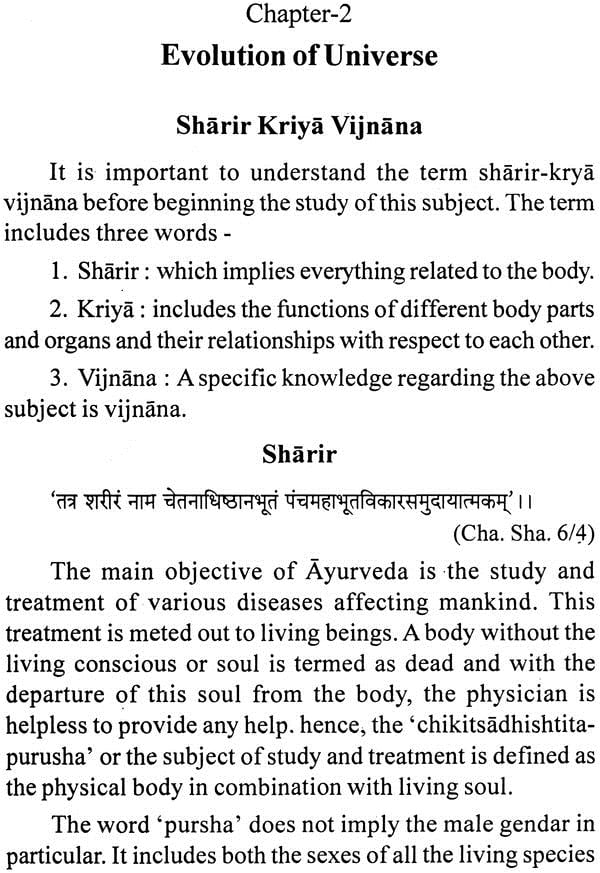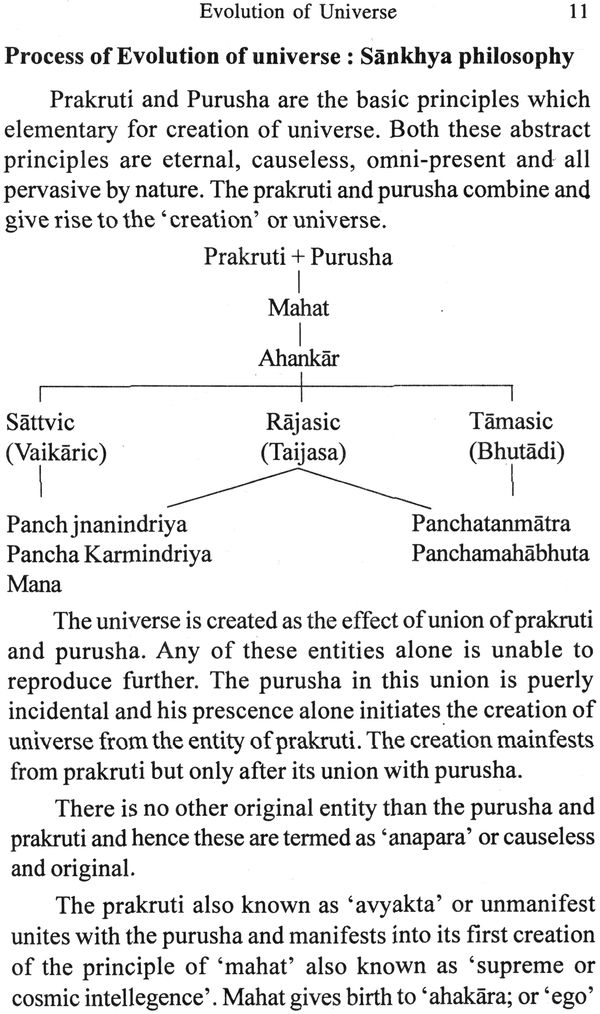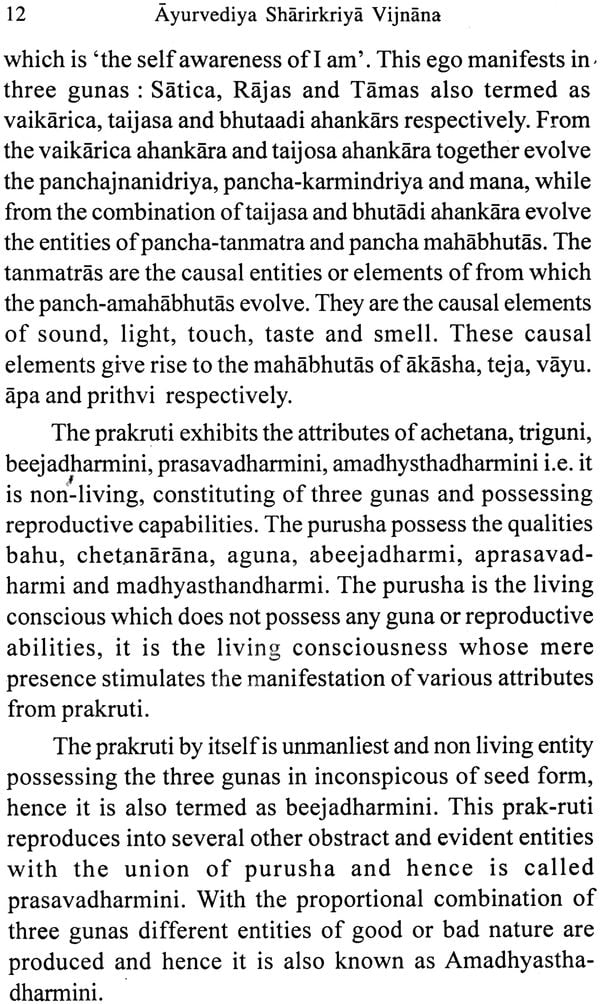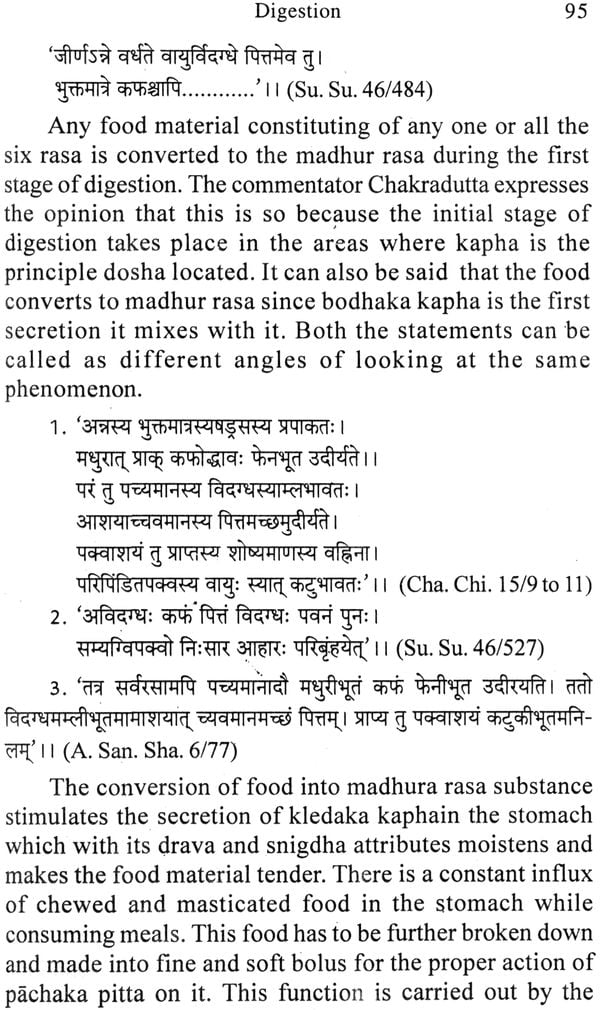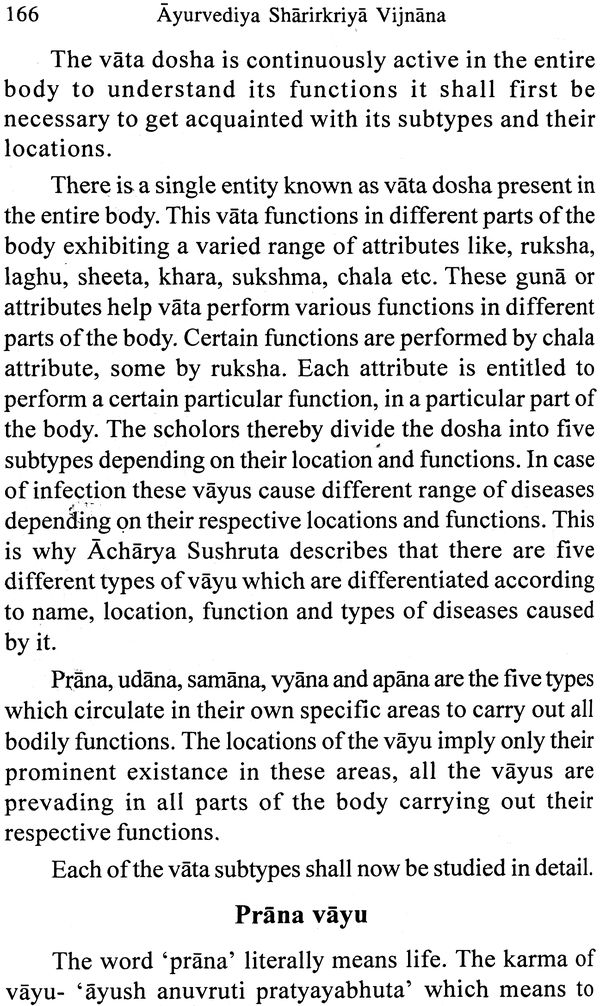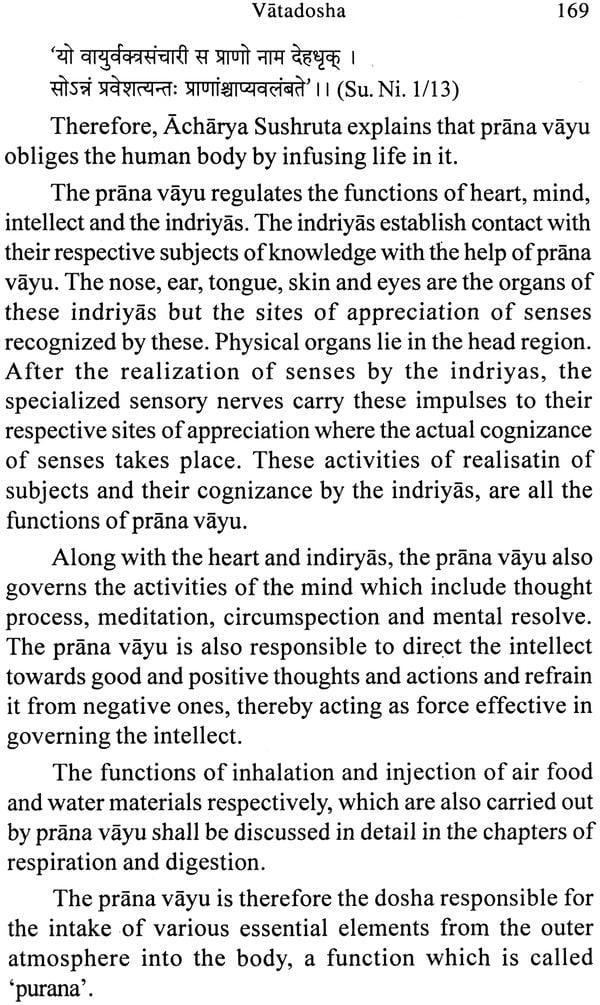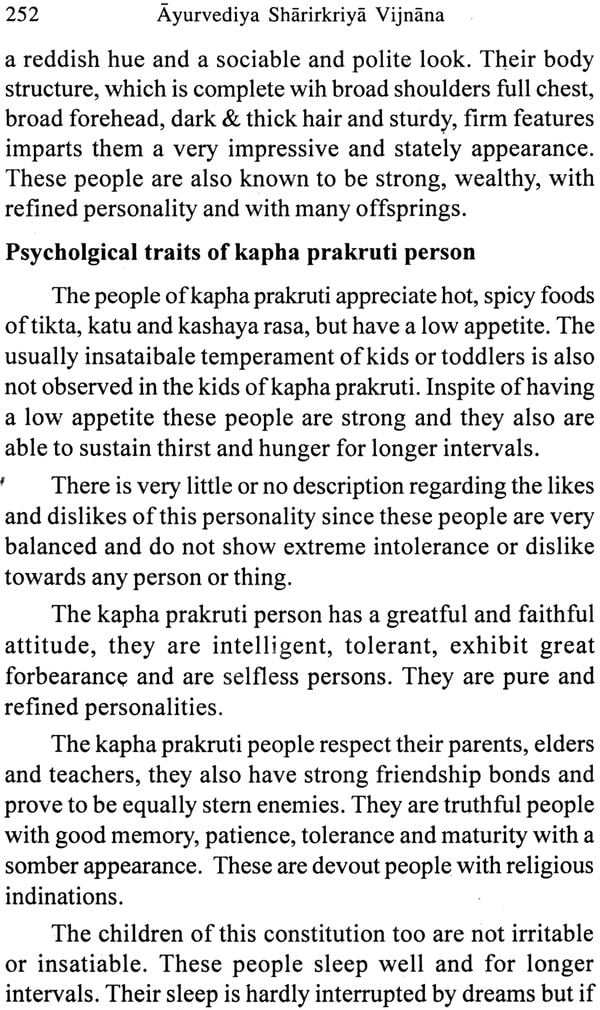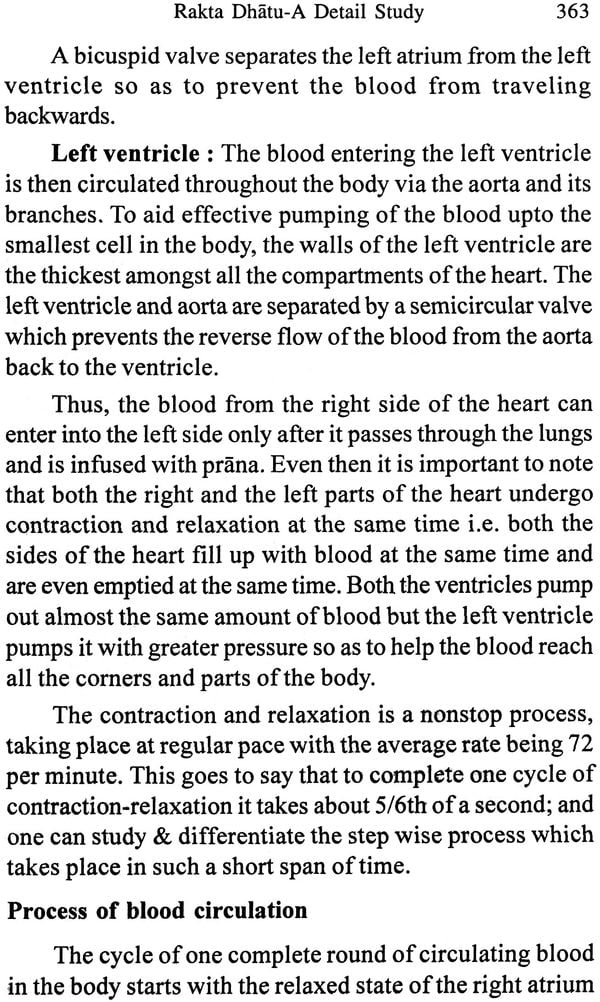
Ayurvediya Sarirakriya Vijnana
Book Specification
| Item Code: | IHL146 |
| Author: | Vaidya Y.G. Joshi,Translated by Vaidya Priya M.Nene |
| Publisher: | Chaukhambha Visvabharati , Varanasi |
| Edition: | 2010 |
| ISBN: | 9788190987110 |
| Pages: | 440 |
| Cover: | Paperback |
| Other Details | 8.5 inch X 5.5 inch |
| Weight | 500 gm |
Book Description
Preface
Having received the priviledge for teaching the subject of Kayachikitsa to the students of Tilak Ayurveda Mahavidyalaya has helped me appreciate the importance of the basic subject of Sharir Kriya the knowledge of Sharir Kriya acquired with respect to the point of view of Chikitsa helps the students reach a better understainging.
Without a thorough comprehension of the basic concepts of ‘Dosha-Dhatu mala’ in their normal balanced state, one is unable to detect any abnormality in the condition of these or any other bodily elements.
Shloka
The ‘svastha’ or the healthy state of being can be physically defined as the balanced state of the doshas in the body. Any imbalance in this state of doshas results in ill health and thence, arises the need for proper medical consultation and treatment. Thus, for offering apt medical treatment for diseases, which are the result of abnormal state of doshas, it is vital to first acknowledge the normal state of doshas. Hence, accurate discrement of the subject of kriya is vital in preparing a sound base for further studies in the field of Ayurvedic Medicine.
With the opportunity of teach Sharir Kriya as a subject, I also realized that the teaching of Sharir kriya subject combined with proper insights into Chikitsa also helps in better understanding of the fundamental concepts and philosophy of Ayurveda. This sole aim and a genuine concern towards the students of Ayurveda has initiated the writing of this volume of Sharir Kriya.
The book includes a detailed description of ‘Sharir Kriya’ as per the Ayurvedic philosophy, accompanied with an overview of the modern or allopathic subject of ‘physiology’ to complete the curriculum of the graduate course as dictated by the C.C.I.M. and accepted by the Ayurveda departments of various state universities. The book also includes as introduction to Yogashastra for a complete appreciation of the subject of Sharir Kriya.
The earlier texts on this subject authored by Vd. Mama Gokhale and Vd. S.G. Vartak provided valuable guidance in the writing of this book.
I wish to express deep appreciation for the efforts of Vd. Medha Joshi, Vd. Archana Barve and Vd. Nandini Dhargalkar, who have been helpful in the compilation of such a vast subject and also those of Vd. Priya Nene who has flawlessly translated the original Marathi version into the universal language of English.
A textbook of the fundamental principles of Ayurveda, this book shall be of immense help to students, practitioners and professors a like to reach a better understanding of the Ayurvedic philosophy and to appreciate the knowledge stored in ancient Ayurvedic texts.
About the Author
Prof. Dr. Y. G. Joshi, a renowned physician in the field of Ayurveda was born on 12th April 1936, in Nipani, Maharashtra. He completed his basic education in Nipani and then acquired the graduate degree of ‘G.F.A.M.’ in the field of Ayurveda, from the Tilak Ayurveda Mahavidyalaya Pune. He then went on to complete his post graduation ‘H.P.A.’ from Jamnagar, Gujrat.
Vd. Y.G. Joshi is the son of Vd. G.R. Joshi Panchanadikar. He finally elected to settle in the city of Pune which witnessed his growth from a young, budding Ayurvedic practioner to an eminent personality/authority in the field of Ayurveda. With immense dedication and a command over each of the topics, Vd. Joshi tutors for a varied range of subjects like. Sharir Kriya, which comprises of the fundamental principle of Ayurvedic Philosophy and Kaya chikitsa, which deals with the diagnosis and management of diseases. He sincere and consistent efforts in imparting information and knowledge regarding Ayurvedic concepts to students and laymen alike are well known. He has always been determined in creating an awareness for the science of Ayurveda in the minds of the general public and also in clearing the misconceptions regarding Ayurvedic concepts and philosophy from the minds of students and doctors from different medical pathies. He has voluntarily participated in lectures, forums and camps with the same aim and forethought in mind.
He joined the Tilak Ayurveda Mahavidyalaya in 1961 as a lecturer and practicing physicians and has graced several positions of authority thereafter. He continues to practice Ayurvedic Medicine with the attached hospital and is equally active in his own private practice.
A brief overview of several responsible possible positions held/graced by Prof. Vd. Y.G. Joshi and his participation in important projects.
| Chapter | Page No. | |
| 1 | Introduction | 3-8 |
| Aims and objectives of Ayurveda | 5 | |
| Difference similarities between Sharir Kriya and Rachana | 8 | |
| 2 | Evolution of Universe | 9-23 |
| Definition of Sharir | 9 | |
| Sankhya Philosophy | 10 | |
| Ayurvedic viewpoint regarding the Process of Evolution of Universe | 13 | |
| Bhutantaranupravesha | 15 | |
| Purusha | 17 | |
| Ayurvedic theory regarding the cause for creation of universe | 17 | |
| Swabhava Vada | 18 | |
| Ishwara Vada | 18 | |
| Kalavada | 19 | |
| Yadruchhavada | 19 | |
| Niyativada | 20 | |
| Parinamavada | 20 | |
| 3 | Chikitsadhishthita Purusha | 24-29 |
| Rashi Purusha | 26 | |
| Karma Purusha | 27 | |
| Sanyoga Purusha | 28 | |
| 4 | Purushajanma-Garbhotpatti | 30-37 |
| Matruja Bhava (Maternal Factors) | 34 | |
| Pitruja Bhava (Paternal Factors) | 35 | |
| Atmaja Bhava | 35 | |
| Rasaja Bhava | 36 | |
| Satvaja Bhava | 36 | |
| Satmaja Bhava | 36 | |
| 5 | The Panchamahabhuta Philosophy | 38-46 |
| Distinguishing characteristics of the mahabhutas | 39 | |
| Animate and Inanimate objects | 40 | |
| Constitution of Chikitsapurusha | 41 | |
| Parthvia Substances | 43 | |
| Apya Substances | 44 | |
| Tejas Substances | 44 | |
| Vayaviya Substances | 45 | |
| Akashiya Substances | 45 | |
| 6 | Atma-Jeevatma | 47-52 |
| 7 | Indriya Vijnana | 53-70 |
| Jnanidriya or Sensory Organs | 53 | |
| Indriya Panchaka | 54 | |
| Indriyartha-Subjects of knowledge or perception | 55 | |
| Tulyayonitva Siddhanta-Theory of Common origin | 56 | |
| Dhyanendriya | 56 | |
| Sparshanidriya-Sense organ of touch (skin) | 57 | |
| Chakshurindriya-Sense organ of sight | 58 | |
| Rasanindriya-Sense organ of taste | 59 | |
| Ghranindriya-Sense organ of smell | 60 | |
| Karmindriya | 60 | |
| Mana or the Mind | 62 | |
| Sleep | ||
| 8 | Digestion | 71-117 |
| Anna Prashasti Eulogy of Food Material | 73 | |
| Body Nourishing Elements | 76 | |
| Diet | 77 | |
| Ahar-Vidhi-Visheshayatanani | 79 | |
| Functional organs of digestion | 82 | |
| Digestion in the Oral Cavity | 85 | |
| Digestion | 87 | |
| Importance of the Process of Udirana or Secretion | 92 | |
| Annaprapaka | 94 | |
| Functions of pachaka pitta | 96 | |
| Functions of Samana Vayu | 98 | |
| Concept of Agni | 99 | |
| Difference between the entities of agni and pitta | 101 | |
| Types of agni | 105 | |
| Jatharagni | 105 | |
| Bhautikagi | 105 | |
| Dhatvagni | 107 | |
| Incitation of vayu | 107 | |
| Concept of kitta | 108 | |
| Purishadhara kala and its functions | 110 | |
| Production of Urine | 112 | |
| Functions of apana vayu | 115 | |
| Important factors in the process of digestion | 116 | |
| 9 | Sukshma Pachana-Anupaka | 118-146 |
| Digestion at Micro levels | 118 | |
| Ahara rasa | 119 | |
| Nutritive and excretory material | 122 | |
| Concept of anupaka | 124 | |
| Functional elements in digestion at micro level | 127 | |
| Sequential production of dhatus | 128 | |
| Time required for production of dhatus | 129 | |
| Formation of fecus and duration required for it | 132 | |
| Concept of upadhatu | 134 | |
| Dadhiksheera nyaya | 137 | |
| Kedari Kulya theory | 137 | |
| Khale Kulya theory | 138 | |
| The ksheeradadhi nyaya | 139 | |
| Kedarikulya nyaya | 141 | |
| Khale kapota nyaya | 143 | |
| 10 | Dosha-Dhatu-Mala | 147-155 |
| Dhatu | 148 | |
| Mala | 148 | |
| Dosha | 149 | |
| Tridosha | 150 | |
| 11 | Vatadosha | 156-182 |
| Evolution | 156 | |
| Etymological interpretation of the word vayu | 157 | |
| Alternative nomenclature | 157 | |
| Functions of Vata dosha | 160 | |
| Prana vayu | 166 | |
| Udana Vayu | 170 | |
| Samana Vayu | 172 | |
| Vyana Vayu | 175 | |
| Apana Vayu | 177 | |
| Interrelation between the vata subtypes | 179 | |
| Eulogy for vata dosha | 180 | |
| 12 | Pittadosha | 183-204 |
| Etymology of pitta | 184 | |
| Alternative nomenclature | 184 | |
| Mahabhuta visesa | 184 | |
| Specific attributes of pitta | 185 | |
| Types of pitta | 192 | |
| Pachaka Pitta | 193 | |
| Ranjaka Pitta | 196 | |
| Sadhaka pitta | 198 | |
| Alochaka pitta | 201 | |
| Bhrajaka pitta | 202 | |
| Interrelation between the pitta subtypes | 203 | |
| 13 | Kapha Dosha | 205-222 |
| Etimological derivation of the word kapha | 206 | |
| Alternative nomenclature | 206 | |
| Mahabhuta vishesha | 206 | |
| Attributes of kapha dosha | 206 | |
| Types of kapha dosha | 214 | |
| Kledaka Kapha | 214 | |
| Avalambaka kapha | 216 | |
| Normal functions of avalambaka kapha | 217 | |
| Bodhaka Kapha | 218 | |
| Tarpaka Kapha | 219 | |
| Shleshaka Kapha | 219 | |
| Inter realationship between kapha subtypes | 220 | |
| Vayu | 221 | |
| Pitta | 221 | |
| Kapha | 222 | |
| 14 | A word about the Tridosha Theory | 223-232 |
| The Panchabhautika constitution of doshas | 226 | |
| Vayu | 228 | |
| Pitta dosha | 228 | |
| Kapha dosha | 229 | |
| Concept of Poshya-Poshaka dhatus | 229 | |
| 15 | Prakruti Vijnana | 233-265 |
| Genesis of Prakruti | 234 | |
| Influence of dosha attributes on expression of prakruti | 237 | |
| Behavioural similitudes depending on Prakruti | 238 | |
| Vata Prakruti | 239 | |
| Psychological traits of vata prakruti person | 243 | |
| Behavioural similitude of vata prakruti (Anukatva) | 244 | |
| Pitta Prakruti | 244 | |
| Psychological traits of pitta prakuti | 247 | |
| Anukatva-Behavioral similituede of kapha prakruti | 253 | |
| Bhautika Prakruti | 254 | |
| Gunamayi Prakruti | 255 | |
| Traits of Satvic Prakruti | 255 | |
| Traits of Rajas Prakruti | 257 | |
| Traits of tamas prakruti | 258 | |
| Seven types of Prakruti | 259 | |
| Examination of Prakruti | 262 | |
| 16 | Concept of Dhatu | 266-306 |
| Rasa dhatu | 267 | |
| Upadhatu and mala | 269 | |
| Eulogy for Rasa Dhatu | 270 | |
| Rasa Vruddhi | 272 | |
| Rasakshaya | 272 | |
| Rakta dhatu | 273 | |
| Etimological derivation | 273 | |
| Alternative names | 274 | |
| Production period | 275 | |
| Eulogy for rakta dhatu | 279 | |
| Rakta Sara | 279 | |
| Specific disease causing factors | 281 | |
| Symptoms of Rakta Vruddhi | 285 | |
| Symptoms of Rakta Kshaya | 285 | |
| Mansa Dhatu | 286 | |
| Alternative names | 286 | |
| Mala and upadhatu | 287 | |
| Symptoms of mansa sara | 288 | |
| Symptoms of mansa vruddhi | 289 | |
| Symptoms of mansa kshaya | 289 | |
| Meda dhatu | 289 | |
| Mala and upadhatu | 290 | |
| Medasara | 291 | |
| Symptoms of meda vruddhi | 292 | |
| Symptoms of meda kshaya | 292 | |
| Asthi Dhatu | 293 | |
| Alternative names | 293 | |
| Types of asthi dhatu | 293 | |
| Upadhatu and mala | 294 | |
| Asthisara | 296 | |
| Symptoms of asthivruddhi | 296 | |
| Symptoms of asthikshaya | 296 | |
| Majja Dhatu | 297 | |
| Types of majja dhatu | 297 | |
| Upadhatu and mala | 297 | |
| Majja Sara | 299 | |
| Symptoms of majja vruddhi | 299 | |
| Symptoms of majja kshaya | 299 | |
| Shukra Dhatu | 300 | |
| Alternative names | 300 | |
| Types of shukra dhatu | 302 | |
| Upadhatu and mala | 302 | |
| Manifestation of shukra dhatu | 303 | |
| Shukrasara | 305 | |
| Symptoms of shukravruddhi | 305 | |
| Symptoms of shukra kshaya | 305 | |
| 17 | Concept of Updhatu | 307-331 |
| Stanya | 309 | |
| Srtava | 312 | |
| Etimology and atternative names | 313 | |
| Symptoms of artara vruddhi | 316 | |
| Symptoms of artara khsaya | 316 | |
| Vasa | 316 | |
| Tvacha | 317 | |
| Snayu | 321 | |
| Oja | 323 | |
| Types of Oja | 327 | |
| Symptoms of Oja vruddhi | 330 | |
| Oja Vikruti | 330 | |
| Oja Visransa | 331 | |
| Oja Vyapad | 331 | |
| Oja Kshaya | 331 | |
| 18 | Malavichar Concept of Mala | 332-344 |
| Purisha | 332 | |
| Purisha dharar kala | 333 | |
| Symptoms of purisha vruddhi | 335 | |
| Symptoms of purisha kshaya | 336 | |
| Mutra | 336 | |
| Symptoms of mutra vruddhi | 337 | |
| Symptoms of mutra ksraya | 338 | |
| Sweda | 338 | |
| Symptoms of sweda vruddhi | 340 | |
| Symptoms of sweda kshaya | 340 | |
| Teeth (Dantal) | 340 | |
| Nails (Nakha) | 342 | |
| Kesha-Loma | 342 | |
| 19 | Srotasa | 345-351 |
| Srotomula-Root or base of srotasa | 348 | |
| 20 | Shwasana Kriya (Respiration) | 352-359 |
| Organs of Respiration | 354 | |
| Process of respiration | 355 | |
| Three steps of respiration | 357 | |
| Internal respiration (Anta Swasana) | 358 | |
| 21 | Rakta Dhatu-A Detail Study | 360-375 |
| Blood Circulaiton | 360 | |
| Heart | 360 | |
| Process of blood circulation | 363 | |
| Heart sounds | 364 | |
| Amount of blood circulated throughout the body | 365 | |
| Ratkadaba (Blood Pressure) | 365 | |
| Blood Circulation | 366 | |
| E.C.G. | 367 | |
| Portal Circulation | 367 | |
| Blood | 370 | |
| Red Blood Corpuscles | 370 | |
| White blood Corpuscles | 371 | |
| Blood Clotting | 372 | |
| Blood Groups | 373 | |
| 22 | Tongue-Organ of Speech | 376-380 |
| Speech-Pronounciation of words | 377 | |
| 23 | Endocrine Glands | 381-399 |
| Characteristic features of endocreineal secretions | 384 | |
| Prostaglandins | 385 | |
| Pituitary gland | 385 | |
| Thyroid Gland | 388 | |
| Adrenal Glands | 391 | |
| Pancreas | 394 | |
| Diabetes Mellitus | 395 | |
| Parathyroid glands | 395 | |
| Testes | 396 | |
| Ovary | 397 | |
| 24 | Central and Autonomous Nervous System | 400-408 |
| Central Nervous System | 401 | |
| Autonomic Nervous System | 402 | |
| 25 | The Yogic Contention Regarding Vayu and Nadi Concepts | 409-415 |
| Yogic hypothesis of Vayu | 409 | |
| Prana Vayu | 410 | |
| Apana Vayu | 410 | |
| Vyana Vayu | 410 | |
| Udana Vayu | 411 | |
| Samana Vayu | 411 | |
| Yogic concept of nadi | 411 | |
| Shatchakra | 413 | |
| 26 | Vikruti Vijnana (Pathology) | 416-440 |
| Dosha Vaishamya | 417 | |
| Common causative factors of dosha vaishamya | 419 | |
| The external causative factors include | 420 | |
| Different states of affected doshas | 421 | |
| Sanchaya | 422 | |
| Prakopa | 423 | |
| Prasara | 424 | |
| Sthana Sanshraya | 426 | |
| Vyakti | 427 | |
| Bheda | 428 | |
| Dosha Gati | 429 | |
| Causes of dosha prakopa and its symptoms | 432 | |
| Causes of Vataprakopa | 433 | |
| Symptoms of Vata vruddhi | 434 | |
| Symptoms of Vata prakopa | 435 | |
| Symptoms of Vata kshaya | 435 | |
| Causes of Pitta Prakopa | 436 | |
| Symptoms of Pitta Vruddhi | 437 | |
| Symptoms of Pitta Kshaya | 438 | |
| Causes of Kapha Prakopa | 438 | |
| Causative factors of kapha prakopa include | 438 | |
| Symptoms of Kapha Vruddhi | 439 | |
| Symptoms of Kapha Prakopa | 439 | |
| Symptoms of Kapha Kshaya | 440 |
